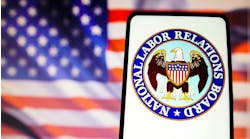For most of the Obama era, the National Labor Relations Board (NLRB) pushed the legal envelope on every front in order to promote the interests of labor unions. Under President Trump, once the board finally attained a Republican majority—even if only for a few days—that battered envelope began to be repaired.
It took until this fall for President Trump to finally nominate and obtain Senate confirmation of two new Republicans to the board, employer attorneys Marvin Kaplan and William Emanuel. Trump also finally nominated and got Peter B. Robb confirmed as the new NLRB General Counsel. Similar to the board members, the general counsel must be confirmed by the Senate. Like the board members, he will serve for a set term of four years and has substantial influence on the board’s policy direction.
With Kaplan and Emanuel joining fellow Republican and Acting Chairman Philip A. Miscimarra, a 3-2 Republican majority finally begin overturning the Obama-Era board’s more controversial decisions—but they had only a short time window to do so. Miscimarra left the board when his term expired on Dec. 16, something he announced earlier he would do, citing family reasons.
With his absence the board faces a 2-2 tie in which the Democrat members can block any further changes until a new Republican member is nominated and confirmed. Keeping this in mind, the Republican majority moved quickly in the last few days before Miscimarra’s departure to reverse several of the Obama-Era board’s most controversial decisions.
In addition, the new General Counsel Robb also issued instructions to the NLRB’s 26 regional directors about how to handle certain cases dealing with union organizing elections, as well as other cases he wants them to pass up to the board for review.
Miscimarra’s influence will be felt for years to come. Although his presence on the Obama-era board was in the minority and he couldn’t stop the former union lawyers in the majority, his written dissents are highly regarded by other attorneys who see them as providing the legal foundation for reversing the previous board’s radical actions.
Joint Employers and Micro Unions
The new revolution began with a vote reversing an earlier decision that extended joint employer liability to labor issues. In 2015 the NLRB held that two entities are joint employers under the National Labor Relations Act where the second employer exercises indirect control over another entity’s employees, or where the second employer has rights of control—even when they have never been exercised.
You read that correctly: The Obama NLRB held that a company could be considered a joint employer even when it did not exercise control over a leasing company’s staff, but there was an even remote chance they might do so some time in the future.
The purpose of this decision was to expand the reach of union organizing to temp staffers in a workplace. Unions have long viewed employers’ use of temp staffing companies as merely a union avoidance tactic, much like reliance on independent contractors.
The new board rejected what it termed a “vague and ill-defined standard” and announced a return to the NLRB’s prior test. To establish joint employer status now, as was true before the 2015 decision, requires proof that a joint employer exercised joint control, rather than merely having reserved the right to exercise control, and that this control be direct and immediate rather than indirect. Also excluded is control that is considered “limited and routine.”
The Republican board also reversed a 2011 decision which made it easier for unions to organize “micro-units” consisting of a minority of employees in a single workplace, such as maintenance workers in an assembly line manufacturing facility.
In the future, the NLRB will not allow unions to create these “micro units” unless it finds the targeted workers share “a community of interest” distinct from the workers not included. The new standard makes it more difficult for unions to cherry-pick smaller, artificial groups of workers in an effort to disenfranchise other employees who would not vote for union representation.
One early and frequent target of the micro union strategy was retailers. In one early case, the NLRB approved a micro unit that consisted only of the women offering perfume samples in a department store, excluding all other employees at the same store.
The National Retail Federation welcomed the micro union decision as well as the one reversing the joint employer standard. “On the heels of the ruling to overturn the expansive joint employer standard, this is another excellent decision by the new NLRB,” said David French, senior vice president for government relations.
“The Obama-era board’s move to validate micro unions created division in workplaces, undermined retail operations and limited opportunities for hardworking employees for the sole purpose of empowering Big Labor,” French added. “It’s clear this NLRB is serious about restoring common sense to the rules governing America’s workplaces.”
“Quickie” Elections Scrutinized
Another decision that unions have found to be helpful to organizing efforts is the “quickie” or “ambush” election rule, which sharply reduced the amount of time between the union seeking an election and it being held from six weeks to an average of 23 days in 2017. While this truncated period made it difficult for employers to mount effective campaigns, that wasn’t the only negative effect stemming from this 2015 decision.
Under the rule, employers were obligated to fulfill numerous additional burdensome bureaucratic requirements in a short period of time, introducing a greater likelihood of error that the NLRB then used to reverse an election that didn’t go the union’s way.
These included requiring employers to provide union organizers with voluminous amounts of information regarding potential voters, including their names, home addresses, phone numbers, e-mail addresses, work locations, shifts and job classifications—all within two days. In addition to creating the likelihood of employer mistakes, this also further exposed employees to “possible harassment and intimidation by union organizers,” according to attorneys Keahn Morris and Garen Dodge of the Sheppard Mullin Richter & Hampton law firm.
Employers also were required to submit a “statement of position” addressing all potential bargaining unit issues the employer intended to raise, or risk waiving the right to litigate those issues at a pre-election hearing.
The NLRB also said pre-election hearings must be held within seven days of the filing of the petition. Morris and Dodge point out that this gave employers little time to find competent counsel and master the complexities of laws governing union representation votes, investigate potential bargaining unit issues, and decide whether to challenge the proposed bargaining unit.
Under the change, many critical election issues could only be addressed after the election was held, resulting in substantial liability risks to employers. The practical impact was that the pro-union board invariably dismissed union campaigning violations as minor and insufficient to overturn an election that favored the union.
However, when employers committed the same sort of minor errors—such as sending the detailed list of employee information one day late—it was judged to be enough to void an election where the union had been defeated. The result was not a revote by the employees, but an automatic victory for the union, which was then automatically certified by the board as the bargaining agent for the employers, even if a majority didn’t want it to be.
On Dec. 12, the Republican board requested public comment to determine whether it should retain the “quickie” election rules without change, modify them in some way, or rescind them completely. If the rules are rescinded, the NLRB sought public input on whether if it should return to the pre-2014 rules or make changes to them.
The comments are due no later than Feb. 12.
Regulating Nonunion Employers
The Obama-era board also sought to further inject itself into nonunion workplaces in a variety of other ways. Several of these were referenced by the new Republican General Counsel Peter Robb in memos he sent to the board’s 26 regional directors about the cases he expects them to send up to the full board for review.
One of these was the earlier general counsel’s determination that nonunion employees facing a disciplinary hearing could request the presence of a union official, even where the union had no other presence in the workplace.
Another way for the board to reach deep into nonunion workplaces was by heavily regulating what employers could and could not choose to include in their employee handbooks, including anything that could even remotely be seen as restricting employees’ rights to discuss wages and working conditions, which is protected by federal labor law. Robb wants to take a closer look at these as well.
He instructed the NLRB regional directors to submit cases where employers were ordered to remove handbook entries that prohibit “disrespectful” conduct, including obscene, vulgar or other highly inappropriate conduct, which was determined to be protected if it involved employees communicating about wages and working conditions.
Other handbook rules Robb wants to review cover restrictions concerning employee use of employer trademarks and logos, and company rules governing “no camera” or “no recording” as well as company policies that require employees maintain the confidentiality of workplace investigations.
Other issues in the GC’s mandatory submission list include an off-duty employee’s access to property, protected work stoppages, disparate treatment of represented employees during contract negotiations, the rights and responsibilities of successor employers when a company is sold, dues checkoff and several more.
In fact, not long after the general counsel issued his memo to the regional directors, the new Republican board voted to rescind an earlier ruling that struck down a Boeing Co. prohibition against employees taking pictures on company premises.
Glenn Spencer, vice president of the U.S. Chamber of Commerce Workforce Freedom Initiative, commented, “Much to the relief of employers, the board’s new approach to employee handbooks would seem to bring down the curtain on the NLRB’s ‘Theater of the Absurd,’” which was the title of a Chamber report on the board’s actions in this area.
However, Robb’s memos have so disturbed the unions that they prevailed on Senators Elizabeth Warren (D-MA) and Patty Murray (D-WA) to write to the new NLRB General Counsel, demanding that he supply them with detailed explanations and background information regarding the contents of his memos.




